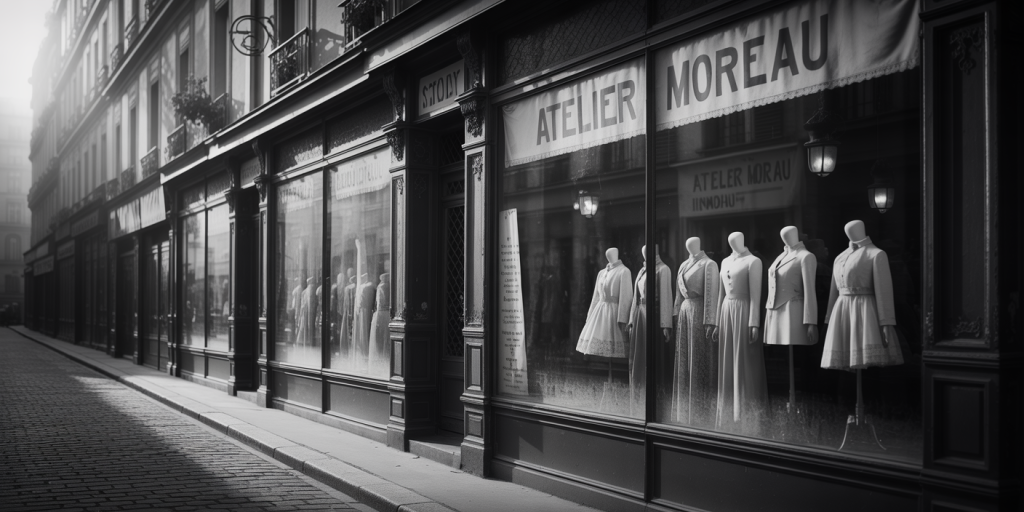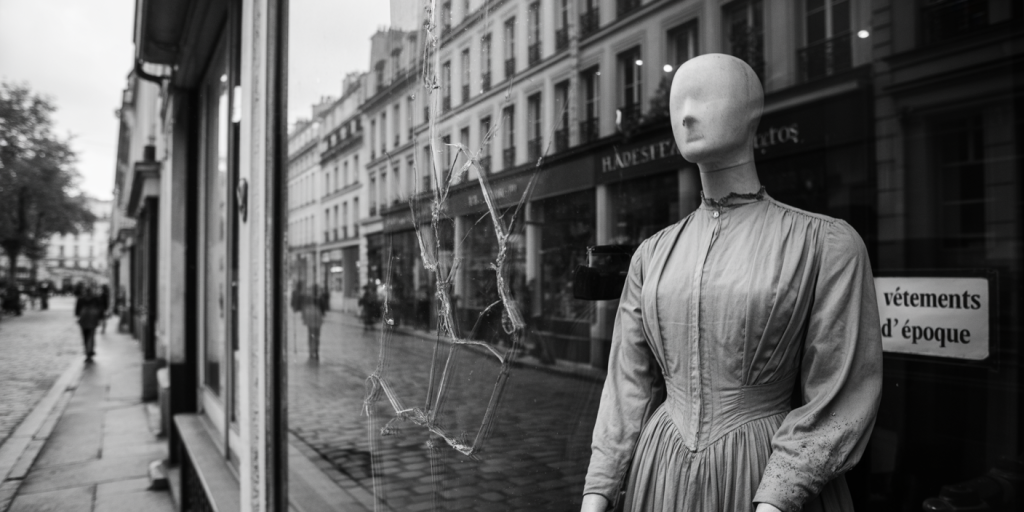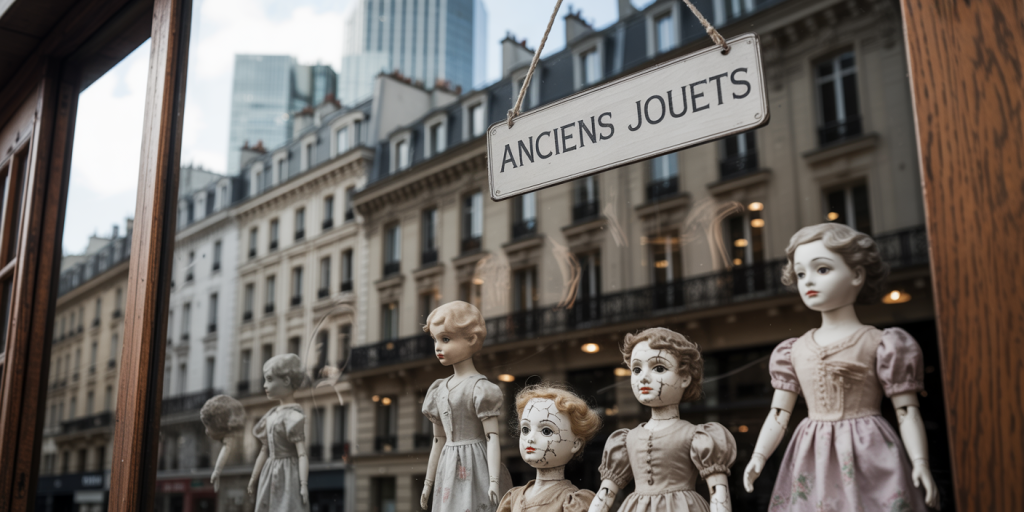The Uncanny Familiarity in the Shop Windows of Eugène Atget – A Estranheza do Familiar nas Vitrines de Eugène Atget
Contemplative Opening
Among the silent reflections of old Paris, there are shop windows that display not merely merchandise, but secrets. In the photographs of Eugène Atget, shop windows do not sell—they whisper. Each dusty pane of glass and rigid mannequin seem to tell stories that were never written, but rather frozen in time, preserved by an eye that knew how to see the invisible.
These are images where the ordinary transforms into ghostly theater. The banal becomes stagecraft. The familiar, strange. Atget, with his camera as a mirror, captured something beyond the surface: the poetry of a sleeping city and the discreet haunting of objects that, although inanimate, seem to watch.

Table of Contents
- The Window as a Threshold Between Worlds
- Reflections of Souls: When the Glass Gazes Back
- Mannequins and the Human Absence
- Time Suspended in Atget’s Gaze
- Textures of Dust and Memory
- The Whispering Light in Shades of Gray
- The City Watching Itself Reflected
- Ghosts in Period Clothing
- The Technique of Silence: Long Exposures and Waiting
- The Motionless Theater of Things;
- Compositions That Cut Reality
- Shop Windows as Psychological Mirrors
- Nostalgia Rooted in Concrete
- Invisible Symbolisms at First Glance
- Absence as Protagonist
- Paris: Body and Stage of a Dream
- When the Familiar Awakens the Uncanny
- Promenade of the Gaze: Walking Unseen
- Dreams in Black and White
- The Shop Window as a Self Portrait of Modernity
The Window as a Threshold Between Worlds
The shop window is not just an exhibition space—it is a portal. Atget transforms it into a boundary between the visible and the hidden. Like a mirror that reveals more than it reflects, these panes become territories where the real and the dreamlike coexist. On one side, the observer’s world; on the other, a still stage.
Atget’s shop windows aren’t open for consumption, but for contemplation. They are frames within frames. Glass borders that enclose suspended narratives, where time doesn’t pass—but breathes.
Reflections of Souls: When the Glass Gazes Back
In these windows, we see reflections that belong not only to the street—but to the past. Facades, distorted passersby, shadows. Everything merges on the glass like a confused dream. The photograph doesn’t merely record what’s in front of the lens but evokes what floats between the eye and the thing.
Atget’s camera captures not just the visible, but the suspended. The reflections of time, of the city, of the urban subconscious.
Mannequins and the Human Absence
These motionless bodies, dressed in the fashion of their day, have no eyes—yet they observe. No mouths—yet they whisper memories. They are unsettling figures that evoke humanity without life. This “simulated life” disturbs—reminding us of what we were and what we pretend to be.
Strangeness lies in the void: no people populate Atget’s frames, yet presence lingers. A spectral, almost spiritual presence. The mannequins are ghosts of consumption that is also ritual.
Time Suspended in Atget’s Gaze
There is no rush in Atget’s images. The Paris he captures seems to have held its breath. Streets are empty, windows quiet, as if awaiting something that will never come. This suspension is aesthetic and emotional—we feel time dripping slowly, like dust settling on old things.
Atget’s use of long exposure techniques reinforces this atmosphere of pause. Nothing moves. And in that stillness, everything shivers silently.
Textures of Dust and Memory
The surfaces Atget photographs are marked by wear: frosted glass, worn furniture, wrinkled fabrics. These textures are not just details—they are remnants of memory. Dust on the windows becomes almost a character.
To touch these surfaces with our eyes is to touch time itself. Each wrinkle in the glass, each fold in the cloth, speaks of a time that no longer exists yet still clings to the material world.
The Whispering Light in Shades of Gray
The light in Atget’s work does not shout. It whispers. Soft nuances, gentle shadows, timid glows. Black and white reveals more than color: it reveals spirit. The absence of hue allows the viewer to plunge into the contrasts of what is spoken and what is withheld.
This light is not merely physical—it is emotional. The light of a midnight dream. Of an interrupted thought. Of a fading memory.
The City Watching Itself Reflected
In the shop windows, Paris sees itself. Facades, lamp posts, architectural lines enter the frame like accidental shadows—and yet they are central. Atget constructs a city that self-reflects, like Narcissus at the edge of the pond.
This urban self-awareness makes us wonder: who watches whom? Could the windows be the true eyes of the city?
Ghosts in Period Clothing
Many of the mannequins wear garments that now resemble costumes. But in Atget’s time, they were present-day fashion. There is constant temporal displacement. What was current has become spectral. What was a display has become a reliquary.
These outfits, devoid of body, are remnants of identity. Ghosts of a bygone elegance. The fabric itself seems to murmur the words of centuries.

The Technique of Silence: Long Exposures and Waiting
Atget worked with heavy wooden equipment. His exposures demanded stillness. And this reflects in the aura of his photos. Each image is the result of patience, of listening, of deliberate stillness. It is as if he knew the city only reveals its secrets to those who do not rush.
This slow technique creates images that also ask to be viewed slowly. These photographs do not shout—they remain. Like echoes of something forgotten.
The Motionless Theater of Things
Each window is a stage. The objects, unmoving actors. The mannequins, speechless protagonists. Atget invites us to watch a play with no beginning or end, where the drama lies in the stillness. The theatricality resides in the arrangement, the quiet composition of form.
As spectators, we become accomplices to this staging. And in the end, we realize the audience is ourselves—reflected in the glass.
Compositions That Cut Reality
The lines of the windows, the borders of panes, the edges of mirrors—everything in Atget is composed like a painting. Each photograph is a geometric construction that slices reality.
But these cuts are not merely visual—they are temporal. Spatial. Emotional. Fragments that, when gathered, form a mosaic of memory.
Shop Windows as Psychological Mirrors
When we look into these windows, we see more than contents. We see our own emotions projected. The strange draws us because we recognize something of ourselves in those stiff, haunting arrangements.
The shop window becomes a mirror—not of face, but of psyche. It reacts to our gaze with silence, but a silence full of echoes.
Nostalgia Rooted in Concrete
There is a delicate sadness in Atget’s images. A nostalgia that does not weep, but sighs. It is the lament of a city changing slowly—but changing. The concrete, the cobbles, the corners—they all seem to hold memories.
This nostalgia is the invisible thread. Each photo a relic. A time capsule made of light and dust.
Invisible Symbolisms at First Glance
Atget never openly declared symbolic intentions. But they are there. A mirror may be vanity. A mannequin, lost identity. A window, involuntary exposure.
The symbolic strength of his photos lies in the unspoken. The implied. It is in this silence that the viewer finds meaning.
Absence as Protagonist
More than any object, what reigns in Atget’s photos is absence. Emptiness. No people. No action. And yet, presence lingers. This contradiction is key. The city lives because it is empty.
Here, emptiness is not lack—but potential. It is the stage, ready. The story, waiting. The breath before the voice.
Paris: Body and Stage of a Dream
Atget’s city is not a place—it is a body. With its streets as veins, its lampposts as bones, its shop windows as eyes. It is an organism asleep, yet pulsing. Each photograph is an X-ray of urban emotion.
It is also stage. A theater where the human is merely suggested, never shown. A dream that refuses to end.
When the Familiar Awakens the Uncanny
The uncanny—the strange within the familiar—is the invisible thread that sews his work. What we see is ordinary, yet it disturbs. Why? Because something is hidden. Something known, yet unnamed.
This unease is Atget’s deepest gift. He teaches us to distrust the obvious. To see the common with new eyes.
Promenade of the Gaze: Walking Unseen
By observing these windows, we walk with our gaze. We become visual flâneurs. Atget invites us to stroll Paris without moving. Each photograph is a step. Each reflection, a turned corner.
And in the end, what we saw was not only the city—but ourselves, in our quiet longing to observe without being observed.
Dreams in Black and White
The black and white of Atget’s photographs is not limitation—it is language. Like in dreams, there is no color, yet there is meaning. Shadows speak. Lights murmur. Contrasts narrate.
These photos are, at their core, dreams. Dreams captured by a man who walked the city with the eyes of a poet and the patience of a monk.
The Shop Window as a Self-Portrait of Modernity
The shop window is a symbol of the modern world: exposure, desire, spectacle. Atget, by photographing it, crafts a self-portrait of his society. A mirror not of himself—but of all of us.
And finally, we realize: we weren’t looking at windows. We were looking at the soul of an era.

FAQ – Frequently Asked Questions
Who was Eugène Atget?
A French photographer from the early 20th century, renowned for documenting Paris with a unique, poetic vision. His work influenced Surrealism and modern photography.
Why are his shop windows so studied?
Because they blur the line between reality and imagination, commerce and poetry, creating tension between the visible and the hidden.
What technique did Atget use?
Large-format cameras with glass plates, slow exposures, and natural light. His process demanded patience and precision.
What was the historical context of his work?
He photographed Paris during a time of transformation, capturing streets and facades that were soon to disappear.
Was his work recognized during his life?
Not widely. He was rediscovered and celebrated later by Surrealist artists and photography historians.
Final Reflections – Echoes in Glass and Shadow
Eugène Atget gave us more than images. He left us with sensations. Fragments of a city that move within us like memories we never lived—but somehow recognize. His shop windows do not sell—they reveal.
The familiar may be the strangest mirror of all. And perhaps that’s what Atget saw first: that sometimes, it takes a silent eye to hear what the ordinary is trying to say.
